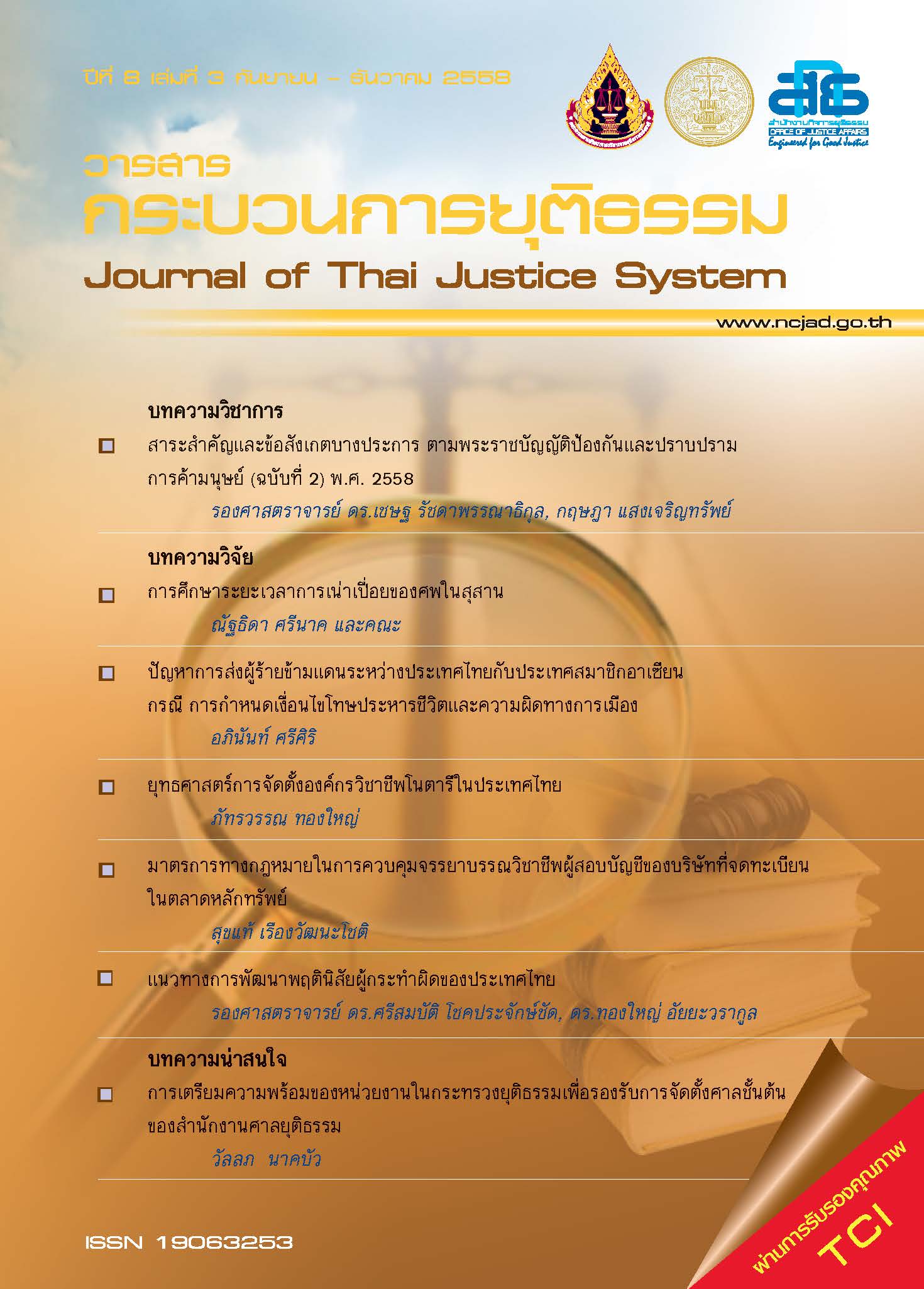การศึกษาระยะเวลาการเน่าเปื่อยของศพในสุสาน
Main Article Content
บทคัดย่อ
การตรวจพิสูจนย์เอกลักษณ์บุคคลด้วยวิธีทางมานุษยวิทยาจะสามารถให้ข้อมูลทางชีวภาพ (biological profile) ได้จากโครงกระดูก ปัจจัยทีสำคัญอย่างหนึ่งคือ โครงกระดูกที่มีส่วนประกอบตามลักษณะทางกายวิภาคที่มีสภาพสมบูรณ์ย่อมสามารถให้ข้อมูลทาชีวภาพของบุคคลที่เป็นเจ้าของโครงกระดูกนั้นได้ดี ดังนั้นการศึกษาระยะเวลาการเน่าเปื่อยของศพในสุสานเพื่อหาระยะเวลาที่เหมาะสมในการนำโครงกระดูกของศพนิรนามขึ้นจากหลุมฝังศพที่สุสานๆ จึงมีความสำคัญในการเป็นต้นทางของการได้มาซึ่งข้อมูลที่ถูกต้องสมบุรณื จากการศึกษานี้พบว่า ระยะเวลาที่เหมาะสมในการนำกระดูกขึ้นจากหลุมศพ เพื่อให้ได้กระดูกที่แยกออกจากกันและยังคงสภาพสมบูรณ์ เหมาะสมต่อการตรวจวิเคราะห์ คือระยะเวลาตั้งแต่ 8 เดือน ถึง 11 เดือน หลังการฝัง โดยปัจจัยที่มีผลต่อการเปลี่ยนแปลงสภาพศพ ได้แก่ สภาพแวดล้อมและภูมิอากาศ พยาธิสภาพและบาดแผล ปัจจัยด้านขนาดรูปร่างและน้ำหนักของศพ รวมถึงการเข้าถึงแมลง
Article Details
ต้นฉบับที่ได้รับการตีพิมพ์ในวารสาร เป็นลิขสิทธิ์ของวารสารกระบวนการยุติธรรม แต่ความคิดเห็นที่ปรากฏในเนื้อหาของบทความในวารสารกระบวนการยุติธรรม ถือเป็นความรับผิดชอบของผู้เขียนแต่เพียงผู้เดียว
เอกสารอ้างอิง
Galloway A. (1996). the Process of Decomposition: A model from the ArizonnaSonoran Deserrt. Forensic Taphonamy: The postmortem fate of Human Remains (1 st ed.) USA: CRC Press.
Vass AA. (2001). Beyond the grave-understanding human decomposition.Microbiology Today. Vol 28. Nov 01 [online]. เข้าถึงถึงข้อมูลวันที่ 1 กันยายน 2557. จาก http://www.academia.dk/Biologist_Antropologi/Tafonomi/PDF/ArpadVass_2001.pdf.
Byers SN. (2001_. Introduction to Forensic Anthropology A textbook (1 st ed.) USA: Allyn & Bacon.
ศูนย์ภูมิอากาศ สำนักพัฒนาอุตุนิยมวิทยา กรมอุตุนิยมวิทยา. (2556). รายงานสภาวะอากาศของประเทศไทย พ.ศ. 2556 [ออนไลน์] เข้าถึงข้อมูลวันที่ 1 กันยายน 2557. จาก http://climate.tmd.go.th/.


